Knowledge you can build upon
Magnifying Six Sigma™ with Organizational Engineering
Rick Norman & Kevin Garrett
Abstract
Six Sigma™ is the dominant quality process in use today. Of the quality tools available, it is the most rigorous, thorough and best documented. However, Six Sigma has a gaping hole in one of the most critical parts—the human engineering side of the process. This article shows that Organizational Engineering technology fills this hole.
Introduction
Six Sigma™ (Motorola, 1991) is perhaps the latest, most powerful, and highest form of the quality techniques available today. Table 1 outlines its major components.
Table 1
Six Sigma Framework and Partial Toolkit

The Six Sigma (6s) toolkit is extensive. Its protocol is rigorous. Its processes are definitive. However, there is a gap. That gap lies in the selection and organization of the human beings who navigate the protocol and deploy the tools.
The Organizational Engineering (OE) Advantage
W. Edwards Deming, the father of quality, recognized the need for improvement in the human element in his "The 14 Obligations of Management" and "Deadly Diseases" (Smith, 2004). But, his guidance tends to be global and unspecified. It includes such things as "institute leadership" and "drive out fear." Just how these concepts are to be applied is left unsaid. Deming's counsel is more of a set of goals than an operational algorithm.
"That gap lies in the selection and organization of the human beings…"
Six Sigma™ attempts to control the human element with a structure of roles. For example, it defines roles for "executive management, a senior champion, project champions, deployment master black belts, project master black belts, process owners and Six Sigma green belts. This structure, it is said, is central to the Six Sigma model for success." (Quality eLine, 2000). A role is an "assignment of authority and accountability for some end or condition" (Salton, 2004). In other words, 6s assigns responsibility but avoids saying how to actually do it. This is a step up from Deming's visionary guidelines but far short of 6s rigor.
Organizational Engineering (OE) is a technology that addresses the gap for operationalizing 6s roles. It is not a "development" program that ends its life as a 3-ring binder on a shelf. It is an engineering solution that optimizes a particular group assigned to a specific task. OE converts the well-intentioned platitudes of Deming and the unspecified directives of 6s into solid, predictable processes.
A Quality Example
Research and development provides an example of OE's use in a quality process. A staged gate process (Cooper, 2001) is used by 60% of firms (Griffin, 1997) to take a product from concept to distribution. Activities are divided into steps. A "go/no-go" gate is inserted at various intervals to cull poorer quality ideas at the earliest point. Cost is avoided and product quality is improved at each gate. Anyone employing this protocol will produce results superior to the "throw it against the wall and see what sticks" R&D strategy.
The staged gate process is well known. Each step in the process represents a unique activity. This means that each step is an opportunity for optimization. Using OE, human assets can be structured so they will optimally satisfy the requirements in a specific step. String 50 of these optimized steps together and a major gain is realized. This kind of gain can be realized in any process that involves unique steps carrying different demands—including 6s.
"The human factors are the ones that usually make or break (Six Sigma)"
Major firms are using OE in R&D but wish to remain anonymous. However even if these firms were to become visible, there would be nothing a competitor could do to duplicate their success. Success and a sustainable competitive advantage depends on the particular people matched to the specific steps in their unique process. Measurable results are within the reach of anyone striving for excellence within a quality process.
Applications to Six Sigma Roles
6s begins with role assignments. Roles are generally agreed upon, however, the exact responsibilities vary. OE is used to inform and guide the exact specifications of these roles. In doing so the odds of success are improved on any 6s project.
Transformational Leadership
6s programs need transformational leaders to succeed. Jack Welch (GE), Larry Bossidy (Allied Signal) and Bob Galvin (Motorola) are frequently cited examples of these types of leaders. Transformational leaders are those prepared to provide the resources, energy and the commitment to see the 6s adoption through to its goal.
OE can identify the people who are likely to be successful in this role. 6s has been defined as "solving a problem with an unknown solution" (SixSigma.US, 2004). Leaders who have significant levels of idea-oriented Relational Innovator (RI) and instant-action Reactive Stimulator (RS) styles would be comfortable in this situation. Fortunately, most CEOs will qualify. A graphic showing the average CEO profile is displayed in Graphic 1.
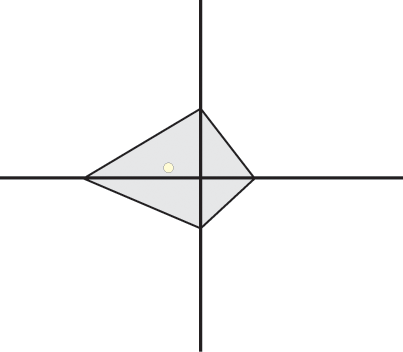
Graphic 1 Profile of the Average CEO
However, hidden within the average profile are CEOs who should not undertake the 6s process. These are executives who rely on structure (HA and LP) and who demand certainty. They will find the "unknown solution" part of 6s very uncomfortable, and their caution will frustrate the 6s process. CEOs with this style inclination should choose a less demanding quality strategy. OE provides the tools to help "fit" the quality program to the CEO. Champions
The "Champions" are upper-level managers who lead 6s implementation efforts. They serve as both Black Belt mentors and as liaisons to top management." (ASQ, 2004). Champions sponsor the effort, are active in selection of projects, ease the integration and supply the necessary resources.
Champions come in different flavors. Those who favor the HA style will see merit in more complex options offering a substantial payout. RS Champions will favor "low hanging" fruit producing quick returns. The RI will tend to be intrigued by innovative options that promise a large return. The LP is likely to favor projects that promise certain returns even at the cost of the need for some patience. Projects that match a Champion's predisposition will be a "natural fit." A bad fit means that 6s projects will suffer.
Advanced knowledge of a Cham-pion's strategic style gives any 6s project an edge. OE takes advantage of the Champion's strengths (every style has them) and acts to offset the Champion's vulnerabilities (these will also be present). The net result is that OE increases the probability of success and lessens tension all around.
Master Black Belts (MBB)
Master Black Belts (MBB) are 6s experts. Their responsibilities "include training and mentoring of Black and Green Belts; helping to prioritize, select and charter high-impact projects; maintaining the integrity of the 6s measurements, improvements and tollgates; and developing, maintaining and revising 6s training materials" (Lopes, 2003).
Technical knowledge is the core of the MBB. The disciplined action of the Logical Processor (LP) is ideally suited to this task. However, technical factors are seldom the critical vulnerability. The human factors are the ones that usually make or break 6s (Keating, 1999). The fuzzy world of human relations is typically not a strength of the LP.
Fortunately, people do not come in single styles. Strategic profiles are a combination of styles. Combining the LP with the analytical Hypothetical Analyzer (HA) and the idea-generating Relational Innovator (RI) styles can provide an ideal MBB mix. The mix of styles shown in Graphic 2 would provide technical expertise, reasons, options and the interpersonal skills necessary to make the technical tools "work" in the real world of business.
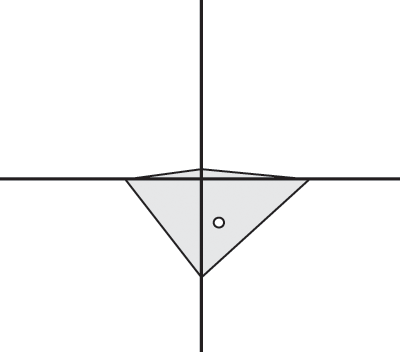
Graphic 2 Optimal Master Black Belt Profile
It is important to understand that people having any profile can satisfy MBB requirements. They may also adequately discharge MBB responsibilities. The optimal profile describes a person who would be comfortable in fulfilling that role over a long period and through multiple projects. Longevity is optimal for a "professional" MBB.
Black Belts (BB)
General Electric defines Black Belts as "leaders of teams responsible for measuring, analyzing, improving and controlling key processes that influence customer satisfaction and/or productivity growth. Black Belts are full-time positions" (General Electric, 2004).
The profiles of MBBs and Black Belts (BBs) tend to be different. The reason is the MBB role has less of a need to "do" anything. MBBs are the thinkers, planners and intellectuals. Black Belts are the doers, achievers and "movers" of the world. BBs must constantly devise ways around challenges that confront 6s projects. They motivate the Green Belt leaders on a daily basis. These "doer" demands cause the optimal profile to shift as shown in Graphic 3.
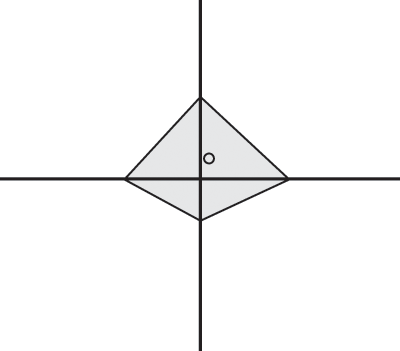
Graphic 3 Optimal Black Belt Profile
The Black Belt profile adds the instant-action RS and idea-generating RI styles to the MBB profile. These are rapid adaptation strategies. These strategies also tend to create the motivational drives of enthusiasm, adventure and excitement. To gain these capacities BBs must subtract from the disciplined LP and HA strategic styles. The reason is simple: one cannot respond quickly with minimal detail (RS) and maintain analytical exactness (HA) at the same time. Great MBBs are not necessarily great Black Belts—and vice versa.
Green Belts (GB)
"Green Belts are Six Sigma team leaders capable of forming and managing six sigma projects from concept to completion" (Pyzdek, 2004). For Green Belts, 6s is a part-time effort occupying 10% to 50% of their time.
The successful Green Belt (GB) can have almost any strategic style profile. 6s is applied to everything from hospitals to manufacturing firms, and from Human Resources to Engineering. The profiles of GBs reflect these different environments. For example, it is unlikely that the profile of a GB from Human Resources will match a profile drawn from sales. The demands of their various primary jobs are very different.
The key to GB success is a three-way simultaneous match. The first step is to match the strategic profile to the project's task profile. Graphic 4 is an example of the overlap between a job profile and a strategic profile. The match is seldom perfect. However, overlap of 50% or more is usually considered high. A person whose "natural" profile matches the job will take more interest, require less effort and probably produce a superior result. There are many jobs within any 6s project, meaning that ample opportunity exists to utilize everyone. Putting GBs in the right place is practical, efficient and effective.
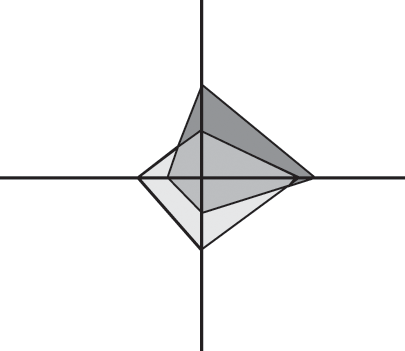
Graphic 4 Step 1: Match Green Belt with Job
The second key is the match between the GB and the team that they are leading. Ideally the GB will have a good overlap with the majority of team members. An average overlap of 40% or better helps assure that a common understanding can be quickly reached. An example of a five-person team that meets this criterion is shown in Graphic 5.
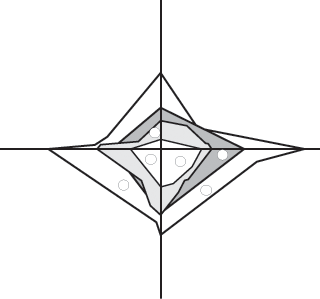
Graphic 5 Step 2: Match Green Belt with Project Team
Finally, the GB should have a reasonable alignment with the Black Belt under whom he/she works. Again, an overlap of 40% or better should be targeted. If the overlap falls below this level, difficulty can be expected. The job can still be done; however, the cost will probably be high. An example of a "moderate" but acceptable overlap is offered in Graphic 6.
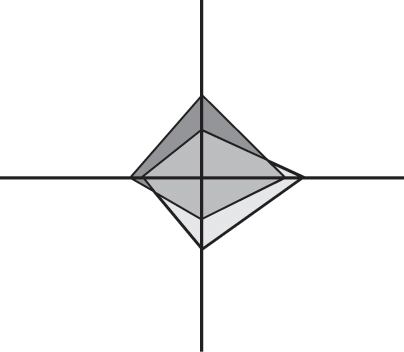
Graphic 6 Step 3: Match Green Belt with Black Belt Leader
Communication challenges can be quickly calculated using OE technology to match the Green Belt with the task, the project team and the Black Belt leader. Simply arranging the MBB, Black Belt and Green Belts can vastly improve the probability of success of a 6s project.
This brief outline highlights some of the implications of the selection and deployment of people to 6s roles. It also gives a sense of the gains available. The concepts and tools outlined can optimize human deployment in a predictable direction with known magnitudes. Measurement replaces guess, solid theory supercedes intuition, and prediction supplants the crossed-fingers of hope. OE is a natural 6s fit.
Application to the 6s Process
Roles are tools for guiding the 6s process. Miscasting people in roles almost ensures a suboptimal performance. But, correctly casting the roles does not ensure success. Each 6s step involves people who do not occupy any of the specified roles. These people are a part of 6s and play a part in its success or failure.
Define Phase:
In this phase customers are identified and high impact characteristics (i.e., "Critical to Quality") as defined by the customer are specified, a team charter is developed and the business process is mapped (Six Sigma.US <1>, 2004).
The steps in the "Define" phase are characterized by a high analytical (HA) component. The HA style should probably dominate the team assigned to this phase. However, if this style is not tempered by an action imperative, a degree of dysfunction can arise due to the HA’s tendency to "ponder." They want to examine every nuance of every issue that has or could arise. This can lead to analytical overkill. OE shows how this can be controlled using a variety of methods. The choice depends on the degree of likely overkill.
- If the exposure is modest, it may be enough to structure the team so that it has an appreciable level of action-oriented RS' in the overall group profile. The presence of people with RS leanings will cause the team to "see" the value of speed.
- If the exposure is moderate, a series of roles or rules might be included in the team charter. An ordinary TeamAnalysis™ will provide a variety of options to choose from.
- If the exposure is severe, a deadline strategy could be the best course to take. HAs are typically sensitive to deadlines. Combining a deadline with the suggestions above should be enough to offset any exposure.
- A TeamAnalysis™ can also identify more esoteric exposures. However, this example is enough to demonstrate the possible value of OE in the Design Phase. Arranging the right people in the right order will systematically produce better results at less cost—every time.
Measure Phase:
In this phase key measures are identified, data collection planned and executed, process variation displayed and communicated, performance baselined, sigma level calculated (Six Sigma <2>, 2004).
Once again this phase has distinct components. Overall, Measure Phase activities benefit from the disciplined LP posture. The key exposure arising with the LP is a tendency to be over exact. The LP can sometimes ignore critical variables not explicitly included in the 6s process. Adding an HA element to the team mix tempers this risk.
Analyze Phase:
In analysis, the team "determines the causes of the problem that needs improvement." This is the natural "turf" for the analytical HA. However, the HA should be supplemented by the other strategic styles. The reason is that each style brings with it a unique perspective that can provide insight that is otherwise unavailable.
For example, the LP is sensitive to operational matters. It is likely that the LP will "see" issues involving the detailed activity sequences that might escape the concept-oriented HA. The RS is heavily focused on task completion. RS' can be expected to "see" motivations that lie outside the process, but influence it none the less. The RI brings the ability to "leap" to identify unexpected relationships that could prove valuable in identifying the root cause. The HA is able to analyze all of these contributions, but left alone, the HA may not "see" the option in the first place.
Improve Phase:
The Improve Phase involves the sum of activities that relate to generating, selecting, and implementing solutions (Six Sigma <3>, 2004). This phase clearly divides into two distinct parts. The first part focuses on creating and testing options. This activity favors the unpatterned strategies of RI and RS. Both of these styles are comfortable working with less than complete information. Both styles are quick in identifying and testing options.
The second part of the Improve Phase involves selection and implementation of a permanent solution. Here the structured styles of HA and LP assume priority, as they are more likely to apply tools such as the "should be" map, contingency plans and the other methods of systematic judgment. HAs and LPs are also better equipped to create implementation plans and use such tools as poka-yoke (Six Sigma, 2004), monitor protocols and develop procedures to ensure a complete solution.
It is not obvious in 6s that different teams are required for the different aspects of the Improve Phase. OE points this out. OE then goes on to show how to weigh the different human components to achieve exceptional results. Again, a perfect 6s fit.
Control Phase:
Control involves keeping the process improvements on the new course. The major risk is reverting back to the "old ways." In the short term this is usually done by developing, documenting and implementing an on-going monitoring plan. Over the longer term, institutionalization by changing systems and structures (staffing, training, incentives, etc.) is usually required.
During this phase, a structured approach (HA/LP) is again favored. Discipline and attention to detail helps ensure that nothing is left out. However, if confined exclusively to the structured styles, a less than optimal result is likely. The reason is that the human element will play a strong role in the success of any 6s process. While structured styles are superb at seeing objective facts, they are usually less than astute at identifying emotional influences. The ideal Control Phase team will have a bias toward structure, but carry with it a strong representation of the unpatterned styles of action-oriented RS and idea-inclined RI. This mix improves the odds that the 6s improvement will really "stick."
The applicability of OE to the phases of the 6s process is indicative only. OE technology is as sophisticated and as deep as is 6s. This overview can only provide a flavor of the benefits to be realized. However, it is sufficient to alert 6s practitioners that there is a gain to be realized. The biggest remaining hole in the 6s process can be filled.
Conclusion
The 6s process is clearly the most powerful quality tool available today. The single gaping hole within its structure can be completely filled by "I Opt" and OE technology. This engineering component is just as rigorous, accurate, thorough and well documented as 6s. It is a natural and perfect fit.
Organizational Engineering is not taught in any existing 6s course. Like 6s, OE's rudiments can be taught to anyone. However, also like 6s, at a professional level the OE discipline is demanding and requires extensive experience to gain all of the benefits available. In other words, some benefit can be gained by mere exposure. All of the benefits are only available by engaging Level III Certified Organizational Engineers. The logic behind this is the same as why architects engage professional structural engineers. Trying to be a "jack of all trades" produces inferior results. 6s is about excellence, not adequacy.
Professional level Organizational Engineering can be "home grown." Many firms have Level III Organizational Engineers on staff. However, those firms that do not, can easily engage outside talent to guide the process at critical junctures. The service is fast, accurate and inexpensive. This outsourcing strategy means that benefits can be gained instantly without the need to develop and deploy another in-house program.
Regardless of how it is obtained, Organizational Engineering belongs within the 6s process. It speaks directly to the two foundations of 6s—its defined roles and its rigorous process. Neglecting to fully address the human component can only result in creating a "chink" in a firm's competitive advantage.
Authors
Rick Norman is a business consultant specializing in Teambuilding and Experiential Learning, Organizational Engineering, Voice of the Customer (VOC) Processes, Setting Customer-Driven Quality Targets for Products and Services, Setting Customer-Driven Organizational Priorities and Focus, Customer-Driven Product and Service Definition and Value Delivery Process Improvement. His career in quality management work began at General Electric in 1979 and continued at Johnson and Johnson in 1985. He has been an independent consultant since 1991 and is is a certified Level III Organizational Engineer.
Kevin Garrett is a business consultant specializing in Teambuilding and Experiential Learning, Communications, Sales Excellence and Collaborative Business Processes. His experience in OE began in 1995 with the use of OE within an educational environment and has branched out to a variety of disciplines from the High Tech Industry to Manufacturing to the Federal Government. Kevin has been an independent consultant practicing with Rick Norman since 1998 and is a Level II Organizational Engineer.
Rick Norman
NCIG, LLC
1106 Congressional Lane
Wilmington, NC 28411-8305
910-686-3815
Rnorman@aol.com
Rick.norman@ncigllc.com
910-297-1058
Kevin Garrett
Kgarrett@ncigllc.com
www.ncigllc.com
oeinstitute.org
Bibliography
American Society for Quality (ASQ), 2004. Six Sigma Program—Champion
Program,
http://www.asq.org/ed/sixsigma/champion/
Cooper RG. (2001). Winning at
New Products. 3rd edition. Cambridge, Massachusetts: Perseus Publishing.
Clauson, Jim, 1998.
Massachusetts Institute of Technology, Center for Advanced Educational
Services, http://deming.eng.clemson.edu/pub/den/deming_philosophy.htm,
Sourced May 13, 2004.
General Electric, 2004.
Glossary of Terms and Definitions Quality Approaches and Models.
http://www.geindustrial.com/cwc/gefanuc/SixSigmaGlossary.html
Griffin, Abbie (1997). Drivers
of NPD Success: The 1997 PDMA Report. Product Development Management
Association.
Herzberg, F., Mausner, B., &
Snyderman, B. B. (1959). The motivation to work (2nd ed.). New York:
John Wiley & Sons.
Institute for Quality
Assurance, 2004. Six Sigma Excelence,
(http://www.iqa.org/publication/c4-1-63.shtml
Six Sigma, 2004. Poka Yoke.
http://www.isixsigma.com/dictionary/Poka_Yoke-74.htm
ISO, 2000. International
Organization for Standardization, Quality Management Principles.
http://isotc176sc2.elysium-ltd.net/QMP.html#Principle2
Lopes, Rubens J, 2003. "Master
Black Belts," isixsigma.com,
http://www.isixsigma.com/
Keating, Elizabeth K., Oliva,
Rogelio, Repenning, Nelson P., Rockart, Scott and Sterman, John D.
(1999). European Management Journal, Vol 17, No. 2, pp. 120-134.
Motorola, Inc., 1991. The "Six
Sigma" name is a trademark and service mark of Motorola, Inc.
http://www.isixsigma.com/library/content/c020816a.asp
Quality eLine, 2000. Six Sigma
and beyond: Deming and Six Sigma. PQ Systems, Sourced 5/9/2004,
http://www.pqsystems.com/eline/2000/04/qualitytip.htm
Porter, Les (2002. Six Sigma
Excellence. QualityWorld. April 2002.
http://www.iqa.org/publication/c4-1-63.shtml
Pyzdek, Thomas (2004). What is
a Black Belt? Quality Digest.
http://www.isixsigma.com/offsite.asp?A=Fr&Url=http://www.qualitydigest.com/feb00/html/sixsigma.html
Salton, Gary J., 2004.
Organizational Engineering Seminar, April, 2004.
Six Sigma.US <1> (2004). Step
1: Six Sigma Define.
http://www.6sigma.us/Step1SixSigmaDefine.html
Six Sigma.US <2> (2004). Step
1: Six Sigma DMAIC Quick Reference - Measure Phase
http://www.isixsigma.com/library/content/six_sigma_dmaic_quickref_measure.asp
Six Sigma.US <3> (2004). Step
3: Six Sigma Improve.
http://www.6sigma.us/Step4SixSigmaImprove.html
Smith, Karl, No date. Quality
and Beyond, University of Minnesota,
http://www.ce.umn.edu/~smith/supplements/staq/supnotes6.html
Waxer, Charles (2004). Six Sigma Organizational Architecture. http://www.isixsigma.com/library/content/c010128a.asp
Organizational Engineering Institute
101 Nickels Arcade
Ann Arbor, MI 48104
734-662-0052
734-662-0838
OEInstitute@aol.com
ISSN: 1531-0566